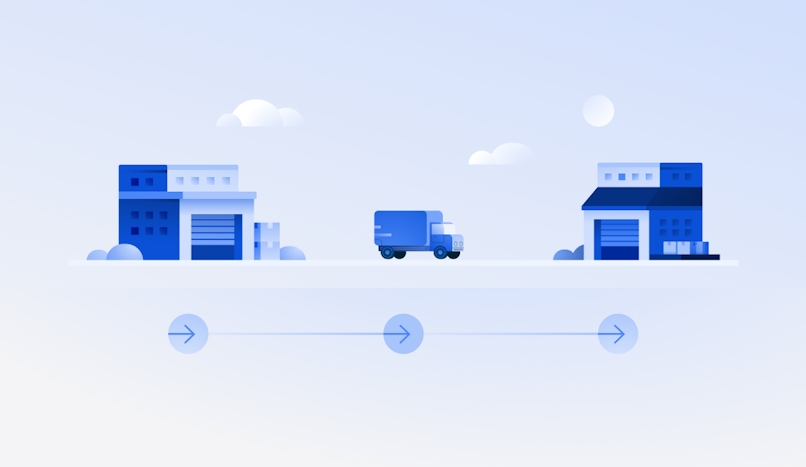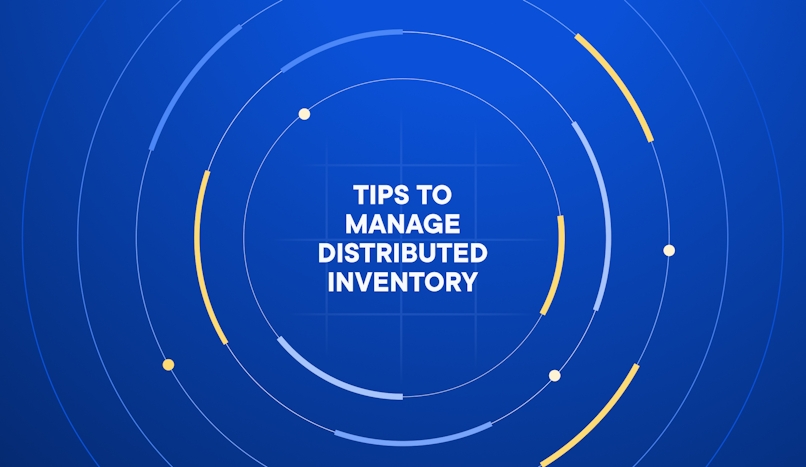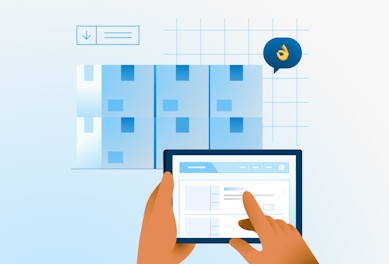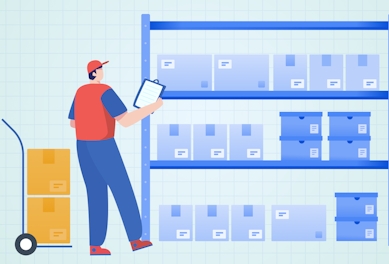What Is Distributed Inventory and How to Manage It Effectively
A distributed inventory system can mean cost savings and improved customer satisfaction. See our tips to manage yours effectively!

Get your inventory out of the warehouse and into customers’ hands faster with optimized route planning from Circuit for Teams.
Distributed inventory means that instead of keeping all your products in one central location, you spread them across multiple locations like warehouses, stores, and distribution centers. Each location maintains its own inventory using systems to track everything.
Read on to learn more about how it works and how to use it.
Key takeaways
- A distributed inventory management system improves inventory control and offers advanced reporting and analytics, helping you make data-based decisions.
- Components like inventory nodes, a central database, data synchronization, and inventory tracking work together to give you up-to-date views of inventory levels in real time across multiple locations.
- A centralized approach consolidates control, a decentralized approach gives more flexibility to individual locations, and a hybrid approach tailors a combination to fit your needs.
- A well-managed inventory system helps you have the right products at the right time and in the right place, guaranteeing customer satisfaction.

How do you manage distributed inventory?
A distributed inventory system can help you effectively manage and monitor inventory across all your locations without breaking a sweat.
A centralized database synchronizes data across all locations, diligently tracks inventory movements, optimizes stock replenishment, helps you fulfill orders efficiently, and even offers valuable analytical insights to help you make smart inventory management decisions.

When should you use a distributed inventory system?
Distributed inventory systems are ideal when you need a customized management solution for inventory across multiple locations. Here are some examples of the organizations most likely to benefit from this type of inventory management:
- Multi-location operations: If you have multiple warehouses, distribution centers, or retail stores, a distributed inventory system can help make sure you have the right products in the right places. This reduces the risk of having too much inventory or losing out on potential sales.
- ECommerce and omnichannel retail: In today's world of on-demand retail, distributed inventory systems help keep stores and fulfillment centers in sync. Inventory accuracy and efficient order management improve customer satisfaction, speed up delivery times, and increase profitability.
- Dropshipping and third-party fulfillment: If your company depends on dropshipping or third-party fulfillment services, a distributed inventory system can make it easier to work with suppliers or distributors by giving real-time visibility into inventory levels. You’ll have accurate information about product availability to process orders efficiently and deliver on time.
- Seasonal and promotional sales: Distributed inventory systems come in handy when dealing with seasonal shifts in customer demand. Accurately forecasting demand and managing inventory can help you always have enough stock for busy periods and promotions.
How does a distributed inventory system work?
In this system, several components work together for smooth and efficient inventory management across multiple locations:
- Inventory nodes: These are the physical warehouses, retail stores, distribution centers, or virtual locations where you store and manage your inventory.
- Centralized database: A common example is an inventory management system (IMS), which stores essential information about the inventory and is accessible to the whole network.
- Data synchronization: Whenever inventory is received, sold, or transferred, these transactions are recorded in real time to keep inventory information consistent across all nodes.
- Tracking: Each inventory item is labeled with a unique barcode or radio frequency identification RFID tag, letting you track items through your system accurately and efficiently.
By combining these components, a distributed inventory system helps you manage inventory across multiple locations, streamline operations, make data-driven decisions, and integrate with your other business systems for improved efficiency and customer satisfaction.
Here are some specific business processes distributed inventory can help with:
Inventory management
When inventory levels decrease, the system triggers stock replenishment requests based on predefined reorder points or sales forecasts.
Replenishment requests are automatically generated or manually initiated by inventory managers.
Suppliers process and fulfill replenishment orders or inventory transfers from other nodes in the network.
Operations
For order fulfillment, the system identifies product availability across all nodes as customer orders come in.
It determines the best node from which to fulfill the order, considering factors like proximity, stock availability, or other defined rules, then initiates the order fulfillment process (picking, packing, and shipping the items from the selected node).
Decision-making
A distributed inventory system aids your decision-making through its reporting and analytics capabilities.
Inventory managers can generate reports on stock levels, demand patterns, sales velocity, and other metrics, allowing you to optimize inventory control, reduce stockouts, minimize carrying costs, and improve supply chain management.
System integration
A distributed inventory system often integrates with other business systems, such as point-of-sale (POS) systems, eCommerce platforms, and enterprise resource planning (ERP) systems.
This integration allows for smooth data flow between operational functions, supporting an accurately recorded amount of inventory and improved efficiency between various systems.
What are the benefits of using a distributed inventory system?
Compared to traditional inventory systems, a distributed inventory system offers significant value in many situations. Here are some of the benefits:
- Real-time visibility into inventory levels across all locations: Easily monitor stock levels, track inventory movements, and make informed decisions based on accurate and up-to-date information. No more guessing games or relying on outdated data!
- Streamlined supply chain operations: Integrating with other systems like point-of-sale (POS) and enterprise resource planning (ERP), the distributed inventory system offers seamless data flow and coordination between various operational functions. This means smoother order management, faster fulfillment, and improved efficiency overall.
- Better inventory accuracy: Manual inventory tracking is prone to errors and discrepancies. Instead, a distributed inventory system uses barcode or (RFID) technology to reduce the risk of stockouts, overstocking, and costly mistakes — and increase your profitability.
- Enhanced customer satisfaction: Leverage the system's real-time inventory data and order management capabilities to fulfill customer orders quickly and accurately. This results in fewer backorders, happier customers, and increased brand loyalty.
- Valuable analytical insights: Generate reports on inventory performance, sales trends, and demand patterns to make data-driven decisions, optimize inventory control, and proactively respond to market fluctuations.
- Ability to adapt: Whether you have a decentralized organizational structure or need customized inventory management processes, tailor the system to suit your unique needs. It's a flexible solution that grows with your business.
So, if you're looking to overcome the challenges of managing inventory across multiple locations and take your inventory management to the next level, a distributed inventory system is the way to go.
It brings valuable benefits that can transform your operations, enhance efficiency, and drive success in today's dynamic business landscape.
Centralized vs. decentralized distributed inventory systems
When it comes to managing inventory data, making decisions, and keeping everything in sync, centralized and decentralized distributed inventory systems have some key differences:
You can combine centralized and decentralized approaches to create a customized inventory management system that fits your specific needs and organizational structure.

5 tips to effectively manage distributed inventory
Managing distributed inventory can seem like a complex task, but the right strategies can help you achieve efficiency and accuracy. Here are five to work with:
1. Centralize your inventory information
Setting up a centralized system or software to keep tabs on inventory across multiple locations is a good idea.
This will give you real-time updates on stock levels, incoming shipments, and outgoing orders so you always know what's happening.
Having a single source for all this allows you to maintain visibility and make smart decisions about when and how much to reorder.
2. Implement robust inventory control procedures
Establishing clear procedures for receiving, storing, and shipping inventory across different locations is important.
Create standardized processes that guide your team on how to accurately record inventory movements. Conduct regular stock counts, and handle any discrepancies that may arise.
Consistency is crucial in maintaining accuracy and minimizing errors, so having these procedures in place keeps everyone on the same page.
3. Optimize forecasting and demand planning
Accurate demand forecasting is crucial for managing your inventory effectively.
Take a deep dive into your historical sales data, market trends, and customer behavior to gain insights and make informed predictions about future demand. You can adjust your inventory levels accordingly by understanding what your customers want and how they behave.
This helps you avoid having too much stock on hand, minimizing excess inventory and preventing frustrating stockouts that leave your customers empty-handed.
4. Establish efficient communication channels
Communication is key when managing distributed inventory.
You need a streamlined method in place for sharing information across all your locations. Everyone needs to be on the same page, whether it's inventory control updates, sales trends, or any supply chain disruptions.
Luckily, some handy tools make communication a breeze. Instant messaging apps, cloud-based collaboration platforms, or regular video conferences can all help facilitate effective team communication.
Staying connected and keeping everyone informed helps you tackle inventory control challenges together.
Embrace technology and automation
Make inventory management a breeze by taking advantage of the technology and automation tools available to you.
Equip your team with handy gadgets like barcode scanners and RFID systems to track inventory movements accurately.
Additionally, invest in reliable inventory management software that can help streamline your processes, reduce human errors, and boost overall efficiency. It's also worth considering integrating your inventory management system with other relevant systems, such as point-of-sale (POS) or enterprise resource planning (ERP).
These integrations allow for seamless data flow and improved accuracy throughout your operations. With the right technology, you'll simplify your inventory management and keep everything running smoothly.
Managing your evolving business needs
When it comes to managing distributed inventory, it's not a one-and-done task. You need to keep an eye on things, evaluate how your inventory is performing, and make adjustments along the way.
Take the time to review and analyze inventory data regularly. Look for areas that could use improvement and identify opportunities to optimize your inventory management practices.
Staying proactive and adaptive can help your strategies align with your business’s evolving needs. Keep monitoring, evaluating, and adjusting to keep your distributed inventory management in top shape.
Keep inventory moving and customers happy with Circuit for Teams
Circuit for Teams offers another key inventory management strategy. It lets you optimize your route planning to save time and money by making sure your inventory gets to your customers at the right place at the right time.
Circuit for Teams does this by integrating customer contact details with each delivery and allowing customers to add detailed delivery instructions. It also lets you run analytics reports to gain deeper insight into your delivery performance.
Plus, you’ll have access to the Circuit for Teams Webhook API. Integrate it with your existing software systems to further streamline your inventory processes. Try Circuit for Teams for free today!




